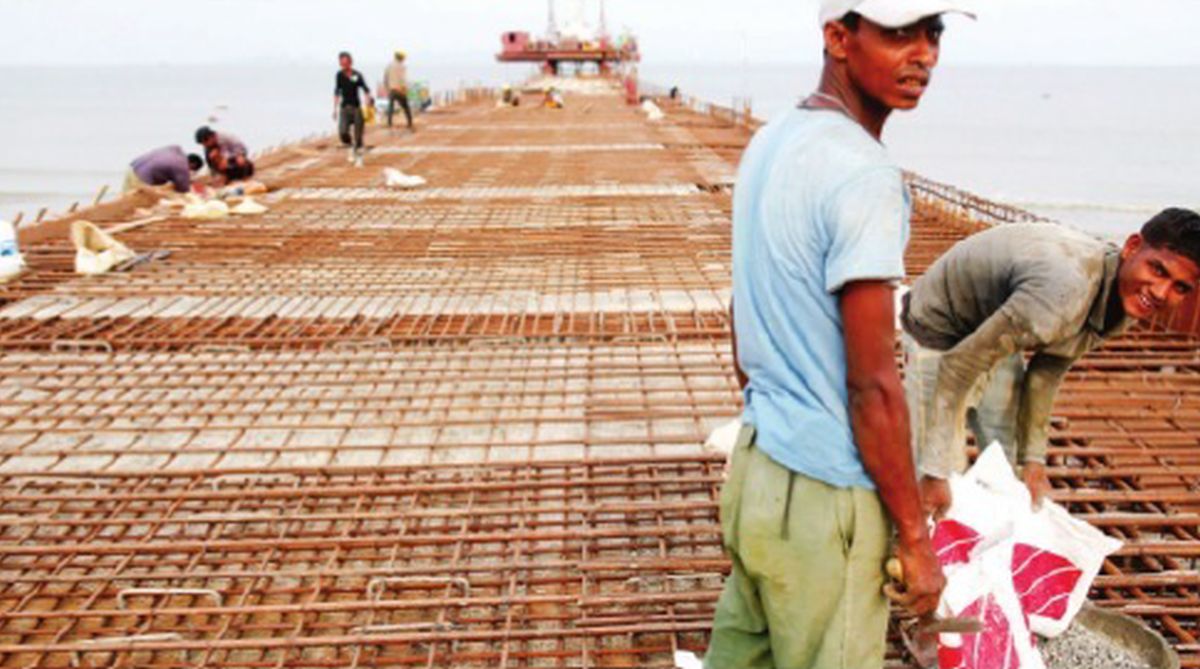PM Modi greets people of Arunachal Pradesh, Mizoram on their Statehood Day
Prime Minister Narendra Modi on Thursday greeted the people of Arunachal Pradesh and Mizoram on their Statehood Day.
The Kaladan Multimodal Transit Transport Project in Myanmar, entirely funded by the Union government, is still far from completion owing to a host of unresolved reasons.

Construction underway at the Sittwe port in Myanmar (file photo).
Come December and President Ram Nath Kovind is expected to visit Myanmar with an aim to witness operationalisation of the Sittwe port in the Rakhine (also known as Arakan) province of the country. The Bay of Bengal port has been developed by India under an ambitious plan called the Kaladan Multimodal Transit Transport Project.
But it may need a few more months to make it completely operational as many parts of the much-hyped project, including road connectivity with Mizoram, are yet to be realised. However, the recent push from New Delhi has resulted in the completion of dredging on the Kaladan river and also, construction of a modern terminal at Paletwa in Chin province.
Advertisement
Initially the project, connecting the alienated North-eastern region with a sea port of Myanmar, was expected to be commissioned by 2015 but the slow progress of the construction of the Paletwa-Zorinpui-Saiha road may further delay the Indo- Myanmar project. The difficult topography and vector-borne diseases have caused so much trouble to workers that it now possesses little chance to make the project operational, even by 2019.
Advertisement
Elevated as an integral part of the Centre’s Act East Policy, the project comprised the development activities of Sittwe port in Arakan, dredging of Kaladan river along with a road link from Paletwa to Aizawl (via Saiha) and finally improving the National Highway connecting Guwahati.
Kaladan (also known as Kolodyne) river, which originates in central Mizoram, culminates in the sea crossing two Myanmar provinces (Chin and Arakan). The river is navigable inside Myanmar — from Paletwa to Bay of Bengal — but prior to that the river has lot of curves and less depth. So the project visualises vessels coming from Sittwe port to navigate through Kaladan river up to Paletwa point and then the goods would be transported by road.
The multi-billion Indian rupees project (US $484 million), conceived in 2003 during the previous NDA regime is expected to bring economic activities to Myanmar’s most underdeveloped Chin and Arakan provinces along with India’s North-eastern region. Entirely financed by the Union government, the initiative is also seen as an option to counter increasing Chinese influence in the neighbouring country.
But in reality, the Beijing administration continues taking advantage of the situation and it has already made operational a crude oil pipeline, parallel to a commissioned natural gas channel, across Myanmar. The crude oil pipeline, connecting Kyaukphyu port of Arakan to Kunming city in the south-western part of the robust country, starts transporting crude oil from West Asia and Africa through Myanmar to feed a huge number of fossil fuel consumers of China.
Now they don’t need to depend on troublesome cargo shipping through the South China Sea (around 5,000 km sailing) for its crude oil imports for the China National Petroleum Corporation-run refineries in the Yunnan province. The 770 kilometre long China-Myanmar crude oil pipeline is a joint venture of CNPC (50.95 per cent stake) and Myanmar Oil and Gas Enterprise (49.1 per cent).
The agreement between China and Myanmar to build the pipelines was signed in 2009 and subsequently, work started the next year. The 793 km natural gas pipeline was readied and made operational by 2015 to carry a billion cubic metres of gas from the Shwe offshore field to southern China localities. Both the pipelines faced numerous challenges as various environmental bodies, rights groups and Myanmarese outfits opposed the venture citing a number of reasons.
However, the CNPC claimed the project was materialised while keeping an eye on environment protection and land restoration. Moreover, emphasis was given on community development activities like building of schools, hospitals, roads, bridges, power and water supply, telecommunication arrangements et al for the benefit of affected families across Myanmar.
Even though India and Myanmar enjoy a lasting relationship, the diplomatic association between Beijing and Rangoon (now the power centre is at Naypyidaw) was also solid as both countries were once under authoritarian rulers. When the Chinese Communist Party led by Mao Zedong emerged victorious in a number of battle fronts in 1949, the semi-democratic government in Rangoon then recognised the People’s Republic of China. By 1950, both countries established formal diplomatic ties.
But as a democratic neighbour, India should — or could — have enjoyed better access to Daw Aung San Suu Kyi, the iconic leader turned influential political entity in Myanmar. The daughter of General Aung San, Suu Kyi stayed in New Delhi for some years and she often mentions Mahatma Gandhi as her inspiration in life.
But on many occasions, things have not moved as expected primarily for New Delhi’s unclear foreign policies. Leaving aside growing opposition from various environment activists based in the Indo-Myanmar border areas, full approval for the Paletwa- Zorinpui road (around 100 km) is yet to be achieved from the Myanmarese authorities. More precisely, extensive work on the Aizawl-Saiha- Zorinpui road on the Indian side is also waiting completion.
The writer is the Guwahati-based Special Representative of The Statesman.
Advertisement